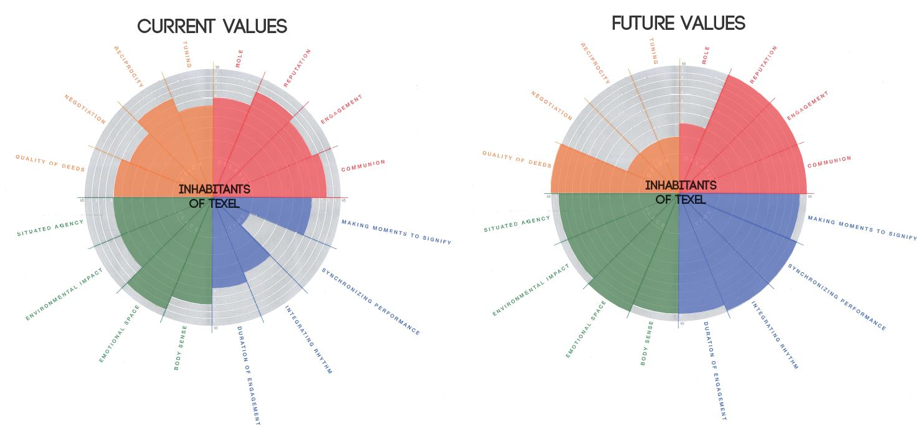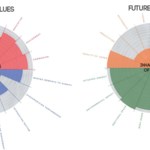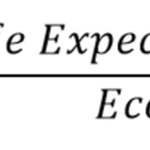In order to design a proper sustainable transition, it is necessary to gather information regarding the main differences between the current state of the sub-system and the sustainable vision set for the future. It was stated that, due to Texel’s vision of becoming self-sustainable by 2020, sustainability is a trend topic in Texel’s society and cooperation from the community is needed in order to reach island’s goal. However, it is still needed to identify the key points that need to be worked on for the transition to be successful and truly sustainable.
The first clear differentiation between the subsystems is the way different elements are connected. In the current situation sustainability initiatives come from the top: local authorities, whilst in the future situation it is expected that, by a joint work of the different groups of Texelaars (young people, entrepreneurs and average inhabitants), (1) the sub-system increases the connections between different elements and (2) the majority of sustainability initiatives come from the population, so the system prioritize ideas from the bottom.
Once this major differences have been remarked, it is necessary to take a closer look to the main changes in the different elements of the system.
Prevailing technologies
Currently, technologies on the island are not entirely focused towards becoming more sustainable. There are unsustainabilities regarding means of transportation, housing, electricity generation, water management, farming techniques, touristic facilities, among others. Due to the pressure generated by the 2020 vision, the main developments have been focused on sustainable energy and sustainable water management (fresh and waste water). Such technologies are not just focus on decreasing the ecological footprint in the energy generation or water treatment, but also in reducing consume rates through behavioural changes. Moreover, most technologies are still under the research stage, so the impact on Texelaars’ lifestyles is still minimum.
On the other hand, in the future sub-system, the range of focus of technological developments is broadened. Sustainability transitions are now focus on developing technology to reduce the ecological footprint trough improving the management of raw materials and waste, decreasing emissions to improve air quality, developing a regenerative approach to agriculture and decreasing the impact of technology on the surrounding ecosystems.
Overall, it can be noticed that the technological development evolves with the needs and growth of society and prioritize its focus in order to solve the major needs the community is facing according to the island’s expected state in time. Technologies already exist and can be adapted to the island, or can be develop by islanders to match their particular needs. Finally, it is clear that there is a need to keep a focus on technological innovation in the island in order to identify key unsustainabilities to be managed and prioritize, and generate proposals to solve them before an escalation of their negative impacts occurs.
Actors
In the current sub-system, the following actors were identified as having the more influence on the system: higher governmental bodies, the municipality of Texel, the Foundation Duurzaam Texel, the Woontij Housing Corporation, Texel Energy and the inhabitants. On the other hand, the future sub-system focuses on empowering young people, the average Texelaar, the entrepreneurs and the visitors with the support of government, institutions and companies.
It is clear that the future sub-system promotes sustainability transition from the bottom while the present pushes it from the top. Additionally, the future sub-system clear states a direction for the interconnection between actors and technologies in such way that technology can be provided to inhabitants to implement sustainable initiatives or technology can be developed by inhabitants to solve an identified unsustainability. Moreover, in the present sub-system, the priority is given to the institutions with the interest, money and power to start the transitions, and the only groups of inhabitants capable of contributing are the entrepreneurs.
Culture and behavior
Figure 1. Value comparison using the YUTPA Analysis
The values of the Texelaar are crucial to the success or failure of sustainable development on Texel. After a few weeks of research, a general idea of the values of the Texelaar were formed. These values were mapped in a YUTPA analysis. YUTPA (acronym for being with You in unity of Time, Place and Action) allows the analysis of four dimensions of significance that refers to presence configurations for making choices and trade-offs for the performance of presence (Nevejan & Brazier, 2014). Moreover, these values were compared with the values proposed for the Texelaar to have in the future to ensure a successful sustainable development. The transition between these values is crucial for the Health, Happiness and Well-being sub-system.
Current values
By looking at the YUTPA analysis of current values, it can be seen that the inhabitants of Texel’s values are quite well distributed among especially three of the four themes. Time is the only theme which is significantly lower than Action, Relation and Place. Some of the higher values that can be found in this analysis of the current system are Emotional Space, Communion, Reputation and Reciprocity. The high values for Communion and Reputation can be traced back to the strong community feeling that Texelaars have, whilst Emotional space has to do with the sense of being on an island. Reciprocity is one that is related to the fact that people, in general, are more inclined to do something if they get something in return that benefits them in the short run.
Future values
By looking at the proposed future values, it can be noticed that a large shift in values for the Texelaar is needed. The values for the themes Relation and Place have been improved slightly, but the major differences can be found within the themes Action and Time.
Within the theme of Action, values for Negotiation, Reciprocity and Tuning have dropped significantly, whilst the value for Quality of deeds has increased to a maximum. In the future sub-system, the Texelaar is not always busy on thinking about short-term benefits, but more about long-term benefits for themselves and their island. This means that values for Negotiation and Reciprocity decrease since people do not necessarily need something in return for the actions they perform. The theme of Relation has an overall improvement, but it is very important to note the decreased value for the Texelaar to have a specific Role. In the future subsystem, everybody can have ideas benefitting sustainability.
The theme of Time is where our largest changes can be found. Sub-system aims to make sustainability a part of the Texelaars daily routine. Therefore, values such as Duration of engagement, Integrating rhythm and Synchronizing performance need to increase. Making moments to signify also increases, so that the Texelaars can commit to certain milestones related to sustainability, and celebrate when they are reached. All values in the theme of Place increase slightly. Since Texel should become self-sustaining, the feeling of being on an island will increase.
Values towards the sustainable transition
In Chapter 1, values were defined to be related to the sustainable transition, they were divided in several categories: family, financial resources, friends, health and fitness, home and place, leadership, leisure pursuits, personal growth, public service, spirituality, and work satisfaction.Each category represents different values. As values may differ between people according to their interests, the analysis of values was done for each of the groups already defined: young people, entrepreneurs and average inhabitants.
For the assessment of the current and future values of the people of Texel, firstly an assumption were made, based on research. Once at Texel, the list of values will be presented to some Texelaars in order to determine whether the assumptions were correct and proper adjustments are going to be made. The results of such assessment can be consulted on the respective links.
Values assessment for the young people of Texel
Values assessment for the entrepreneurs of Texel
Values assessment for the average inhabitant of Texel
From this analysis, it can be concluded that entrepreneurs are the citizens of Texel with the more values related to sustainability. It would be necessary to analyze the influence they have on the other groups in order to facilitate the diffusion of the values in the island. Moreover, it is necessary to open more spaces for them to spread the values related to entrepreneurship and the enjoyment of doing something is positively affecting the quality of your life as an initial step for the transition.
In addition, young people was identified as the group with the highest potential to make the transition happen as their values can be shaped as they are not totally defined yet. The main challenge is to make them relate their professional and personal development with island’s development in order to overcome the desire to go away without coming back and to promote on them the capacities to shape the island they want.
Finally, average inhabitants can be the group more resistant to the transition as their lifestyles are settled. It would be necessary to find proper ways for entrepreneurs and young people to influence their behaviors for them to start making the transition towards sustainability. Consequently, it is expected that, over time, materialistic values such as financial resources will become less important, whilst the overall feeling of this strong community is amplified.
Technologies embedded in cultural behavior
In the current sub-system, the technologies that are most embedded in cultural behaviors are the ones that provides inhabitants benefits for both themselves and the environment such as solar panels, fresh water irrigation system and thermal insulation glass, characterized to be accessible and financially profitable.
On the other hand, the future sub-system is design as a platform that promotes, monitor and highlights technological development in order to integrate it to Texel’s lifestyle. It creates a connection between actors, technologies and values in order to ensure the fulfillment of the sustainable vision through the identification of needs, improvement of required facilities and measurement of success using pre-defined criteria.
Moreover, the success of the technology implementation is highly related to the perception of benefits from its use in the current sub-system. In contrast, the future subsystem creates and takes advantage of the interconnections among elements to maintain an innovative environment towards the resolution of identified unsustainabilities in the areas. Additionally, it is self-driven even though a strong initial push would be needed to gain inertia.
Rules and regulations
Currently, the municipality of Texel has gone beyond the established regulations when established. Apart from this one and regulations regarding education and conservation of the island, there are no further legal framework relevant for the Health, Happiness and Well-being sub-system. On the other hand, the future sub-system needs a strategy to maintain support mechanisms towards behavior that encourages innovation and open communication, in addition to coordination between the different set of sustainability proposals coming from the different sub-systems. As norms cultivate reliable guidelines for daily living, it is expected that in the future sub-system some regulations have to be created to maintain order and give room for opportunities generation and innovation’s implementation. Consequently, the lack of framework present in the current sub-system needs to be filled with norms and regulations capable to give some order to interactions among the elements of the sub-system.
Developments towards the desired direction
Due to the unsustainability mechanisms identified in the current sub-system (chapter 2), interaction mechanisms were redesign in the future sub-system (chapter 3) to support the transition towards a more sustainable island in terms of the sustainability criteria. Moreover, such mechanisms were reflected in the long-term impact proposals to be presented in chapter 5. Furthermore, the trends identified in the current sub-system were used as a basement to define short-term impact proposals to promote an initial experience of sustainable happiness in the island.
After the analysis was completed, it was evident that the sub-system still missed a clear measure of success in order to realize if the results of the initiatives’ implementation were leading the system towards the desired direction. At that point, the Happy Planet Index (HPI) was referenced as the leading measure for sustainable well-being, and it was evaluated as an appropriate tool to measure the success of the implementation of sustainable happiness in Texel. Generally, the HPI is used for countries; however, it would be ideal for the platform’s proper management to adapt the measure to the island scope in order to ensure a proven good measurement tool and enough data to compare Texel’s development with global standards in terms of sustainability.
The Happy Texel Index (HPI, 2015)
The HPI measures “the extent to which countries deliver long, happy, sustainable lives for the people that live in them”. It is an efficiency measure on how many long and happy lives countries are capable to produce per unit of environmental input. It has a scale from 0 to 100 with a proposed target value for nations of 89, and it recommends to use complementary measures in order to not to lose focus on other relevant objectives related with well-being and sustainability. In the case of Texel, this measurement will be complemented with the data from the other proposed sustainability criteria.
Figure 2. HPI Formula
Firstly, life satisfaction is assessed with “The ladder of life” question from Gallup World Poll, the respondents are asked to located themselves in a scale that goes from zero (worst possible life) to 10 (best possible life). Secondly, life expectancy is a globally used measure of health. Finally, the ecological footprint of resources consumption promoted by WWF is used, and it is a measure of the amount of land, per capita, required to sustain a country’s consumption patterns.
The HPI is going to be adapted to Texel by defining the scope of the ecological footprint calculations and starting specific measures on life expectancy and experienced well-being. It is important for the index to be implemented prior to the starting point for the implementation of the proposals (2020) in order to have a baseline scenario to compare future developments.
References
Nevejan, C., Brazier, F. (2014). Design for the value of Presence. Participatory Systems Initiative. Delft University of Technology. The Netherlands: Delft.
HPI (2015). About the Happy Planet Index. Retrieved on January 8, 2015, from: http://www.happyplanetindex.org/about/



